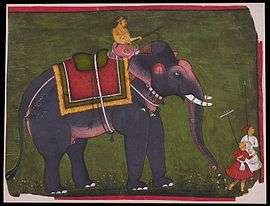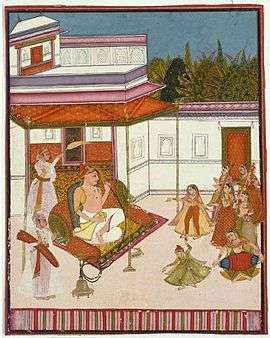Bundi State
| Bundi State बूंदी रियासत | ||||||
| Princely State of British India | ||||||
| ||||||
| ||||||
 | ||||||
| History | ||||||
| • | Established | 1342 | ||||
| • | Independence of India | 1949 | ||||
| Area | ||||||
| • | 1931 | 5,750 km2 (2,220 sq mi) | ||||
| Population | ||||||
| • | 1931 | 216,722 | ||||
| Density | 37.7 /km2 (97.6 /sq mi) | |||||
| Today part of | India | |||||
| | ||||||




Bundi State[1] was a princely state in the era of British India. Its relations with the British were managed by the Rajputana Agency. The last ruler of Bundi State signed the accession to join the Indian Union in 1949.
The Haraoti-Tonk Agency, with headquarters at Deoli, dealt with the states of Tonk and Bundi, as well as with the state of Shahpura.[2]
History
Bundi State was founded in 1342. On 10 Feb 1818 it became a British protectorate. Bundi's last ruler signed the accession to the Indian Union on 7 April 1949.[3]
Rulers
The hereditary rulers of Bundi used the title ‘Rao’ before being granted the prefix ‘Raja’ by the Mughals. A Raja is a ruler of exalted rank but inferior to Maharana or Maharawal.
- Rao Deva (1343 to 1342).
- Rao Napuji.
- Rao Hamuli (1384 to 1400).
- Rao Birsingh (1400 to 1415).
- Rao Biru (1415 to 1470).
- Rao Bandu (1470 to 1491).
- Rao Narayan Das (1491 to 1527).
- Rao Suraj Mal (1527 to 1531).
- Rao Surtan Singh (1531 to 1544).
- Rao Raja Surjan Singh (1544 to 1585).
- Rao Raja Bhoj Singh (1585 to 1608).
- Rao Raja Ratan Singh (1608 to 1632).
- Rao Raja Chhattar Sal Singh (1632 to 1658).
- Rao Raja Bhao Singh (1658 to1682).
- Rao Raja Anirudh Singh (1682 to 1696).
- Rao Raja Budh Singh (b. ... - d. 1739) (1696 to 1735).
- Rao Raja Dalel Singh (b. 1729 - d. 1804) (1735 to 1749).
- Rao Raja Umaid Singh (1749 to 1770) and again (1773 to 1804).
- Rao Raja Ajit Singh (b. ... - d. 1773) (1770 to 1773).
- Rao Raja Bishen Singh (b. ... - d. 1821) (1804 to 14 May 1821).
- Maharao Raja Ram Singh Sahib Bahadur (b. 1811 - d. 1889) (1821 to 28 Mar 1889).
- Colonel HH Maharao Raja Shri Sir Raghubir Singh Sahib Bahadur (b. 1869 - d. 1927) (12 April 1889 to 28 Jul 1927).
- Major HH Maharao Raja Shri Sir Iishwari Singh Bahadur (b. 1893 - d. 1945) (8 Aug 1927 to 3 Apr 1945).
- Col. HH Maharao Raja Shri Bahadur Singh Bahadur (1945 to 1977).
- HH Maharao Raja Ranjit Singh (b. 1920 - d. 1977) (1977 to 07-01-2010).
Coat of arms
The coat of arms of Bundi was a shield depicting a warrior emerging from flames, signifying the creation-legend of the ruling Chauhan clan of Rajputs which was supposedly created from fire. The shield is flanked by cows representing dharma or righteousness; it is crowned by a hand holding a Katar.[4]
See also
References
- ↑ Imperial Gazetteer of India, v. 9, p. 80.
- ↑ Imperial Gazetteer of India vol. IV (1907), The Indian Empire, Administrative, Published under the authority of His Majesty's Secretary of State for India in Council, Oxford at the Clarendon Press. Pp. xxx, 1 map, 552
- ↑ Princely States of India
- ↑ The Princely Armory. Publ. by The Office of the Superintendent of Government Printing. Calcutta. 1877
External links
 Media related to Bundi State at Wikimedia Commons
Media related to Bundi State at Wikimedia Commons
Coordinates: 25°26′N 75°38′E / 25.44°N 75.64°E

